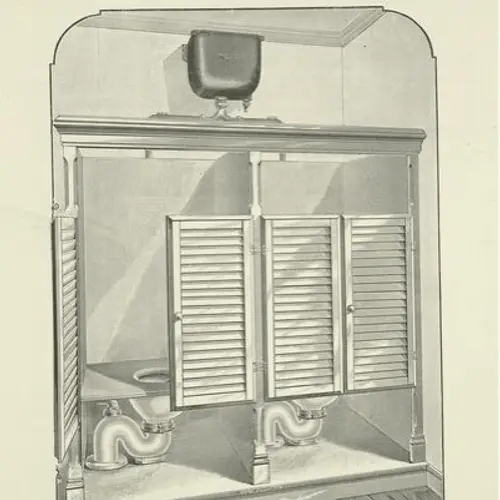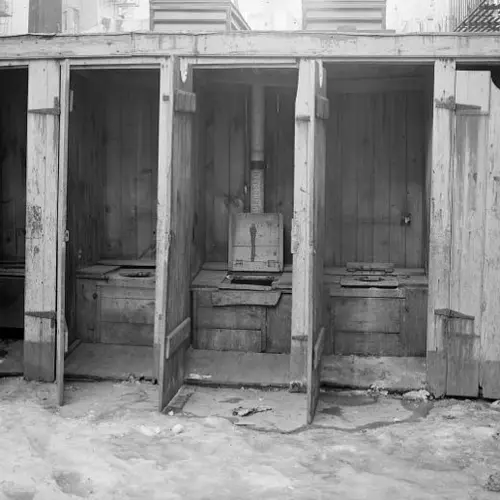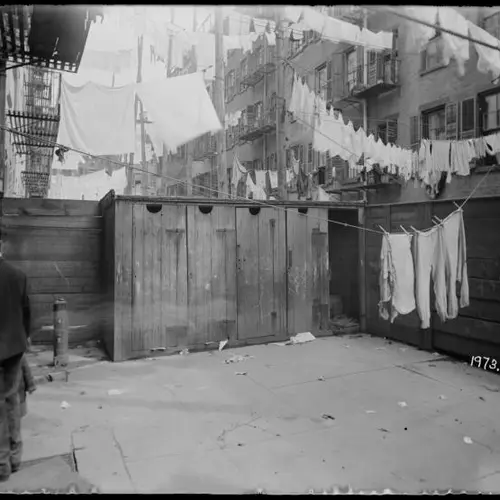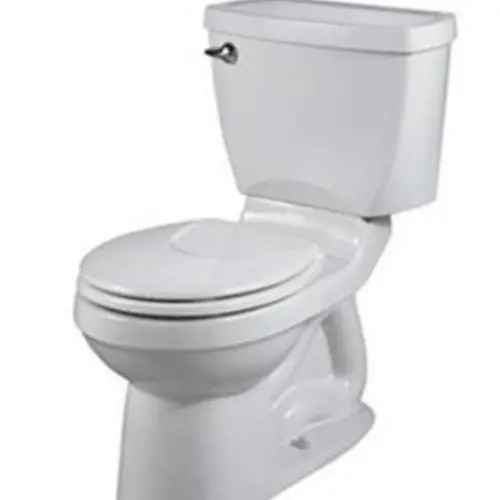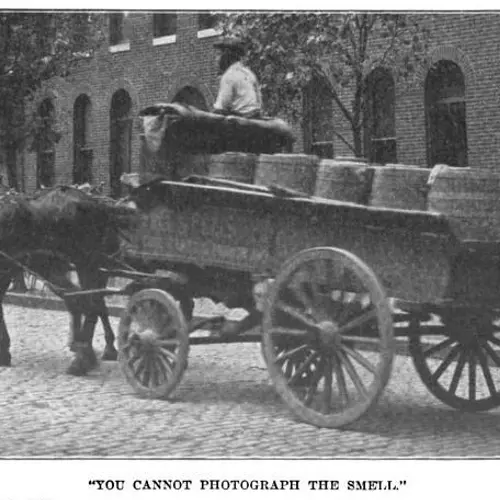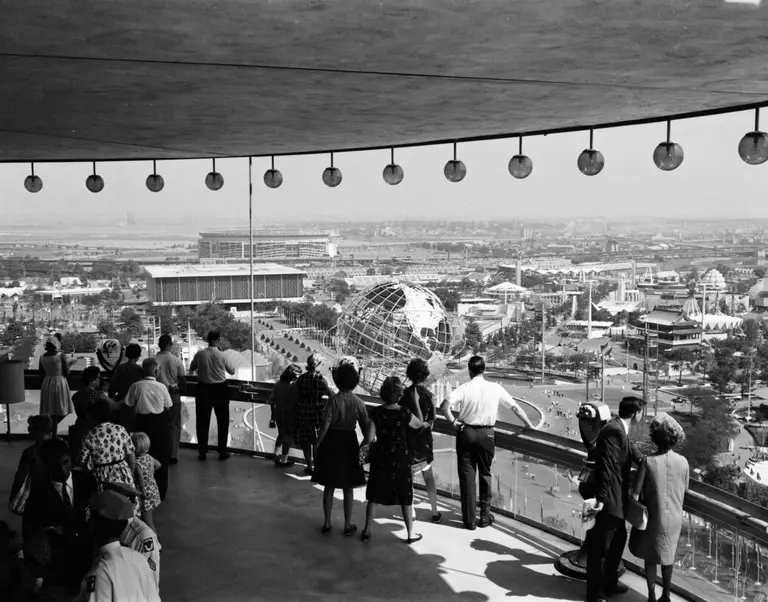Life in New York City before indoor toilets
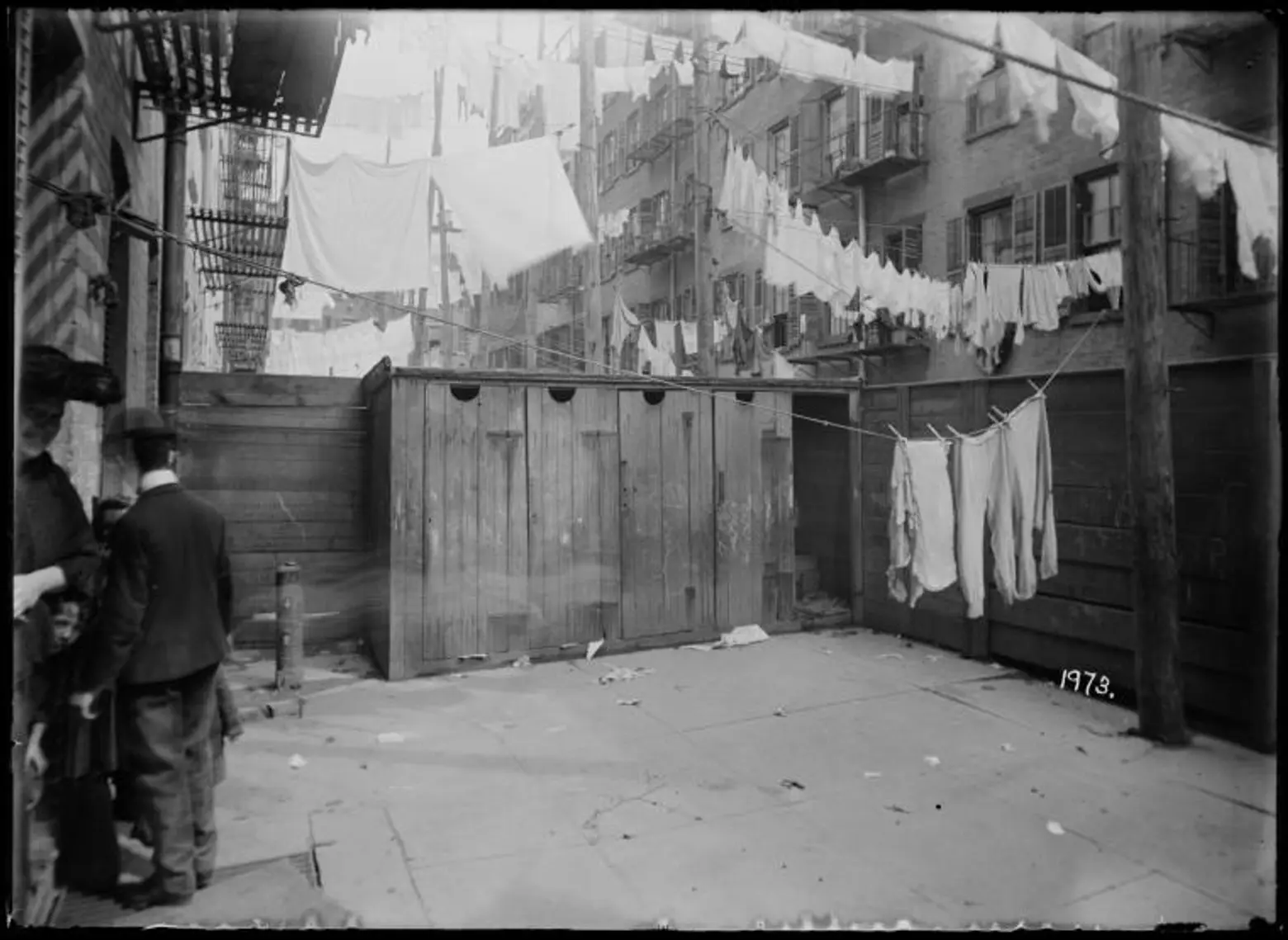
Image: The New York Public Library Digital Collections. 1902 – 1914
If you’ve ever bemoaned the fact that you share a bathroom with several family members or housemates, you’re not alone. Most New Yorkers live in apartments and most units have just a single bathroom. A hundred and fifty years ago, however, the situation was much worse. At the time, New Yorkers had just a few choices when it came to taking care of their lavatory needs and by modern standards, none of the options were appealing—visit an outhouse or use a chamber pot. Nevertheless, indoor toilets proved slow to gain popularity when they were first introduced in the second half of the nineteenth century. Initially, many residents feared the newfangled invention would bring poisonous gases into their homes, leading to illness and even death.
Outhouses and Chamber Pots
Until the late nineteenth century, most New Yorkers relied solely on outhouses located in backyards and alleys. While some residents had their own private outhouses, anyone living in a tenement would have shared facilities with their neighbors. The outhouse/resident ratio varied, but most tenements had just three to four outhouses, and as reported in Jacob Riis’s “How the Other Half Lives,” in the nineteenth century, it was not uncommon to find over 100 people living in a single tenement building. This meant that people often shared a single outhouse with anywhere from 25 to 30 of their neighbors, making long line-ups and limited privacy common problems. As one might expect, most tenement outhouses were also teeming with rats and other vermin and were a major source of disease.
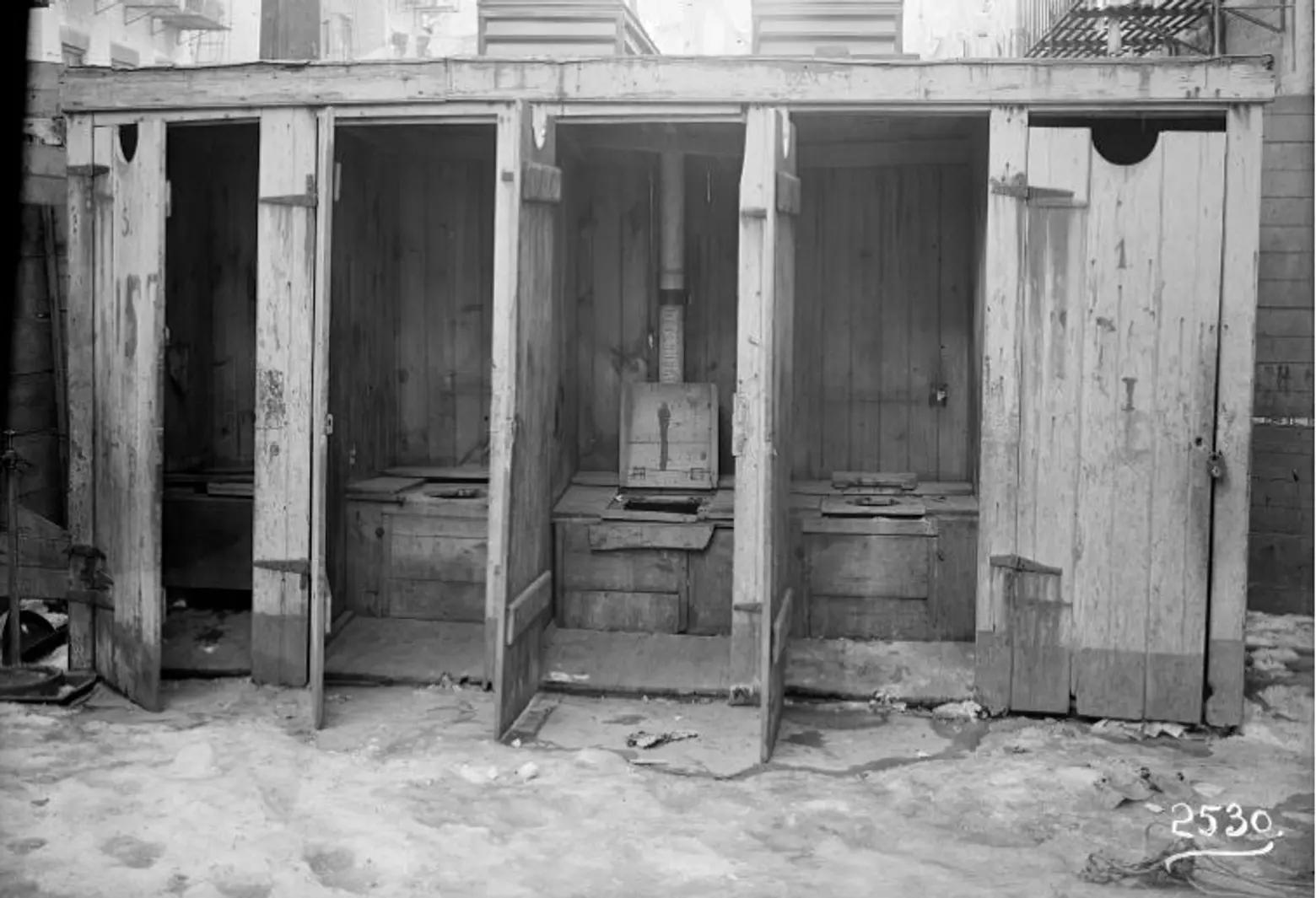 Irma and Paul Milstein Division of United States History, Local History and Genealogy, The New York Public Library. “Row of outhouses” The New York Public Library Digital Collections. 1902 – 1914.
Irma and Paul Milstein Division of United States History, Local History and Genealogy, The New York Public Library. “Row of outhouses” The New York Public Library Digital Collections. 1902 – 1914.
If bathroom breaks were undesirable in the daytime hours, at night, especially in the dead of winter when running down several flights of stairs to street level posed additional dangers, most city residents turned to their chamber pots. Chamber pots, usually earthenware vessels, were typically stored under beds. Since most tenements had little or no ventilation, however, the stench from the chamber pots could quickly become unbearable. To help control the stench, chamber pots had to be emptied into backyard outhouses on a regular basis. Unsurprisingly, carrying pots full of human waste through the dark and narrow halls of a tenement was also no one’s favorite chore.
The Business of Removing the City’s “Night Soil”
Outside the city, outhouses were usually temporary structures built over a hole in the ground. As the holes filled up, the outhouses were simply moved to a new location and the holes covered over with fresh soil. In urban areas, limited space meant that most outhouses were permanent structures. This also meant that removing human waste was a thriving business in the nineteenth-century New York.
At the time, human waste was euphemistically known as “night soil.” This is presumably because the so-called night soil cart men, who worked for companies that had been lucky enough to win a coveted city contract for waste removal, made their living largely after dark. Their unenviable job involved shoveling waste from the city’s outhouses into carts (sometimes other garbage and animal carcasses would also be collected) and then disposing of the contents.
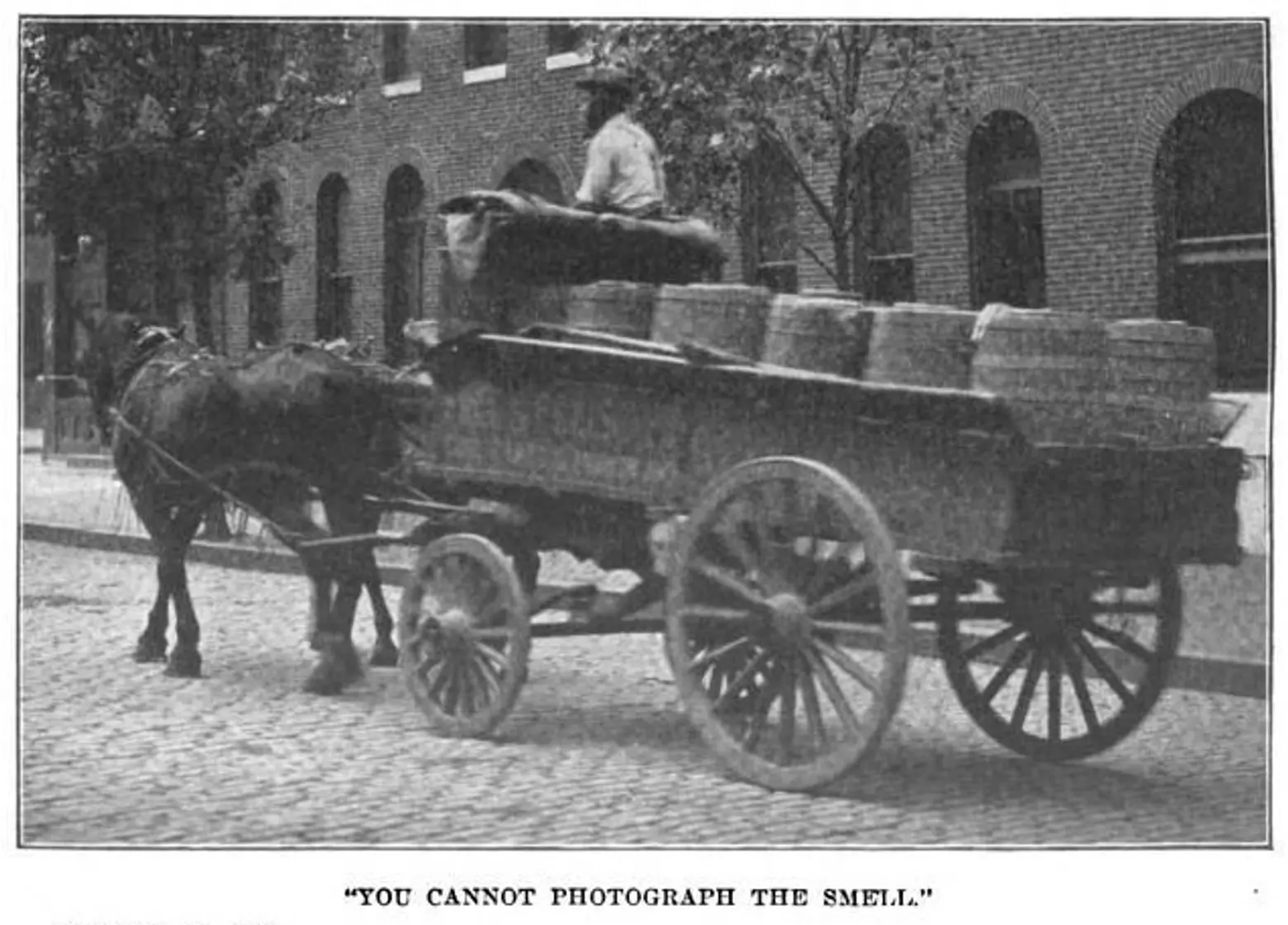 A night soil man. Images WikiCommons
A night soil man. Images WikiCommons
So where did the city’s night soil go?
Although at least some of New York’s night soil ended up being dumped in empty lots on the Upper West Side (some of this human excrement was reportedly even used as fertilizer during the construction of Central Park), most of the city’s night soil was dumped into the city’s surrounding waterways. At best, the night soil was placed on steamboats and dumped far out in the harbor (this form of dumping was legal at the time). At worst, the night soil was simply dumped off the side of piers located on the East River and Hudson.
On March 30, 1878, a report in the New York Times described a scene that took place on the East River at the foot of 95th Street. In this case, two police officers reported seeing a man on deck of a boat just off shore “who, with a crank, was unloading the boat and allowing the contents to run through the side into the river.” The officers, who later testified to the Board of Police, explained, “they saw the boat rise in the water gradually as the contents flowed into the river, and the stench during the operation was intolerable.” Unfortunately, such incidents were by no means uncommon at the time, since dumping night soil into local waterways was far less expensive than using steamboats to cart the waste out into the harbor.
The Arrival of Indoor Toilets and Fear of Sewer Gases
By the time indoor toilets arrived in New York City, they were far from new. The first patent for a flushing lavatory was issued in 1775 to Scottish inventor Alexander Cumming. In the coming decades, Cumming’s invention would continue to be perfected, but still, indoor toilets did not become the norm in most cities until the late nineteenth century and did not reach many rural areas until decades later. In New York, two obstacles slowed the arrival of indoor toilets.
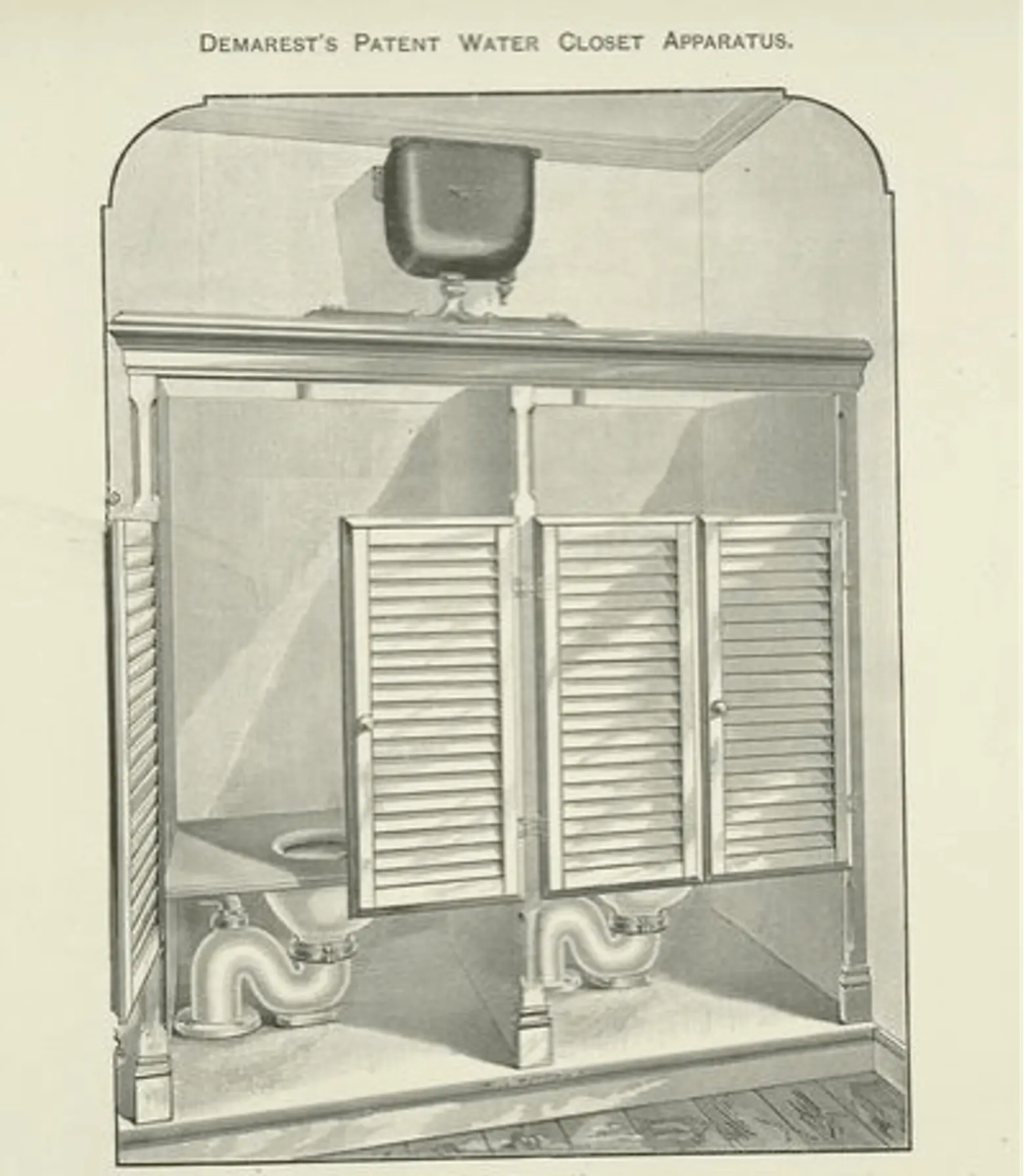 Science, Industry and Business Library: General Collection, The New York Public Library. “Demarest’s Patent Water Closet Apparatus.” The New York Public Library Digital Collections. 1888.
Science, Industry and Business Library: General Collection, The New York Public Library. “Demarest’s Patent Water Closet Apparatus.” The New York Public Library Digital Collections. 1888.
First, there was the problem of creating a sewage system in an already developed urban area. Today, New York is home to over 6,000 miles of mains and pipes with some of the pipes dating back to the mid-nineteenth century. Laying sewage pipes under an already existing urban area, however, proved to be a difficult, costly and at times politically contentious endeavor. For this reason, Brooklyn, which developed later, had a distinct advantage and outpaced Manhattan on the sewage front.
The other obstacle was an at-the-time broadly accepted theory about sewer gases. Given the health concerns and unpleasant smells associated with outhouses, one might assume that city residents would have rapidly embraced indoor toilets. In fact, indoor toilets were met with mixed reviews in the mid to late nineteenth century and many residents initially viewed this advance in sanitation as a potentially deadly conduit of disease. Notably, the fear of dangerous gases rising up from the city’s sewers and resulting in serious illness and even death was driven both by urban legend and by the medical professions’ alleged findings. While sewer gases are a nuisance (modern plumbing usually prevents the gases from seeping into homes), in the nineteenth century, many physicians and the general public believed that if inhaled, the gases could lead to severe illness and even death, because there was a strong conviction that the gases carried disease.
In the pointedly titled 1881 publication, “Sewer-Gases and Its Dangers,” George Preston Brown warns, “Wherever there are sewers, it is certain there will be sewer-gas. If confined to the sewer, it can do no harm…it is only when it finds its way into houses…that it becomes the enemy of the human race.” Among other ailments, Brown reports that sewer gases carry into people’s homes diseases ranging from typhoid, typhus, and scarlet fever to cholera, dysentery and croup. In an 1882 address to the Academy of Medicine, Dr. Frank H. Hamilton sought to send a similar warning to his audience, but unlike Brown, who appeared to believe that proper plumbing could solve the problem, Dr. Hamilton advised that closets, drains, and pipes be put in an annex outside one’s living quarters: “Not a few of our lately constructed and most elegant mansions have not an inch of plumbing in those portions of their buildings which are usually occupied by their families.”
Legislating Indoor Toilets
It was not until the turn of the 20th century that most people in the medical profession agreed that sewer gases were not a source of disease and that on the contrary, continuing to deny city residents access to indoor toilets was contributing to the spread of deadly diseases. With this realization, the push to install indoor toilets and running water across New York City intensified. The Tenement Act of 1901 clearly states, “In every tenement house here after erected there shall be a separate water-closet in a separate compartment within each apartment.” Although new tenement construction had to comply and nearly all buildings erected after 1910 were built with indoor toilets, many existing tenement owners were slow to come into line with the new regulations. Indeed, in 1937, an estimated 165,000 families living in tenements were still without access to private indoor toilets.
Today, anyone with an address in New York City should have access to an indoor toilet, but there is one resident who is likely more grateful for indoor toilets than anyone else. The New York Post recently reported that Vincenzo Giurbino, an NYC Housing Authority “toilet tech,” made an impressive $228,633 in overtime during the last fiscal year. This means that in New York City, a toilet tech who is willing to spend up to 70 hours per week unclogging NYC Housing Authority toilets can take home over $375,000 per year—this tops Mayor de Blasio’s annual take-home salary by more than $100,000.
RELATED:
